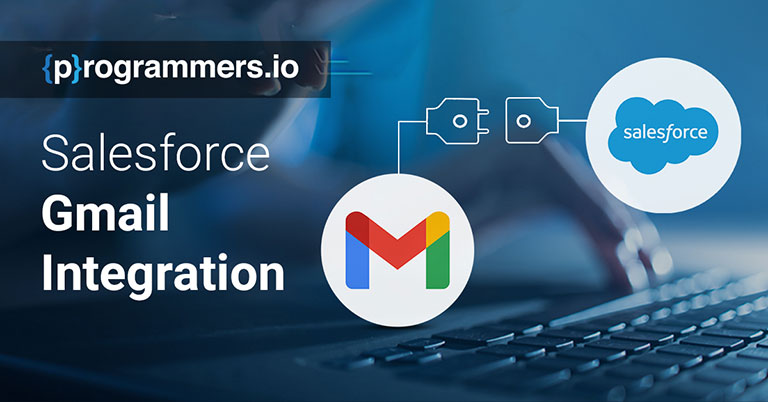While the numbers vary among studies, a conservative estimate is that a typical employee uses anywhere between eight to twelve different applications/software a day to complete their routine work tasks. Switching among different apps and software has become second nature for us, and we don’t even account for the transition time (which may accumulate to several minutes a day) or the pacing difference (in different apps/software), which ultimately impacts productivity. This is an area that integrations aim to solve, and one noteworthy integration that all Salesforce users should know about is Salesforce Gmail integration.
What is Salesforce Gmail Integration?
Salesforce Gmail Integration is the process and functionality of the Salesforce platform that allows users to connect Gmail to Salesforce in such a way that you can create and modify data on Salesforce directly from Gmail. This saves time by reducing manual iterations/logging of the data you have on email and vice-versa.
Salesforce Gmail Integration has been available for at least five years now, and it has become an important and highly sought-after feature simply because of how extensively Gmail is used for email communication in almost all business spaces. Despite private domains and dedicated email clients becoming more commonplace and affordable, the majority of startups and an extensive number of small to medium-sized businesses around the globe use Gmail to reach out to their customers and partners. If they are also using Salesforce to manage their customers, they can leverage the Salesforce Gmail Integration to sync their Gmail data and contacts and perform several other tasks in one place (Gmail) instead of porting the information to Salesforce manually.
How is the Salesforce Gmail Integration Done?
If you think you need to hire a salesforce developer or salesforce programmer for this task, rest assured that you don’t need to. The process is quite simple and has two core elements:
- Searching for and turning on the “Gmail Integration and Sync” feature in Salesforce
- Enter your email and provide relevant permissions from the email side.
While this connects your Salesforce to your Gmail account, there is a lot more you can do with the features available within this integration. Note that if you are using Gmail on your desktop, you can use the Chrome browser and the Salesforce extension available in Chrome for this integration. You can also use a Salesforce connector for this integration to work on your Gmail phone app.
Should You Hire A Salesforce Developer/Salesforce Programmer?
Yes, but not for Salesforce Gmail Integration. You may hire a Salesforce developer for a specific project or a Salesforce programmer to develop applications and features specific to your business use case that may allow you to leverage the full strength of the CRM platform.
However, you may need to hire a Salesforce Developer if you are using Gmail to not just connect with your customers but to run comprehensive email campaigns you need to have your Gmail connected to other platforms and tools as well, and you need all the relevant integrations adequately orchestrated for your business processes.
Why Should You Go For Salesforce Gmail Integration?
The overarching benefit is that it allows a business to make changes to Salesforce data or add data and contacts into Salesforce directly from their Gmail accounts, thus reducing redundancies and repetitions. In more concrete terms, this integration allows you to streamline your work. You don’t have to switch between your Gmail and your Salesforce accounts, and since you may have more comprehensive and 24/7 access to the Gmail account, you may be able to perform certain tasks via this integration without the need to access your Salesforce account.
Other reasons this integration can be highly useful to your business are:
- Once you have your Gmail synced to your Salesforce, you will have access to the most up-to-date contacts and information on both platforms since it will be updated in real-time. If you receive an email on your Gmail account where more customers or employees of your client business are copied, you can ensure that all those email addresses are updated in your Salesforce account so the next email or update sent to them via the platform goes out to all the relevant individuals.
- You can also access your Salesforce Tasks from Gmail and take care of all the email-related tasks while updating their status without the need to switch to your Salesforce account. The same can be done for opportunities, events, and cases, and any other custom categories you may have on Salesforce.
- You can use templates and email shortcuts available in your Salesforce account to make communication with customers faster, more streamlined, and more consistent. This can be especially useful if you have access to company templates on your Salesforce account.
- You can also schedule your emails for the right delivery time based on data obtained from Salesforce. There is also an email tracking feature that also includes a link tracking feature, both of which can be used to track the success of certain emails and links and to gauge customer interest.
Now that Einstein Copilot is also available with Salesforce, users may be able to do much more with their Salesforce Gmail integration. This may include writing emails with the help of the Copilot, personalized mass emails, automating email delivery, and several other things.
Final Words
You don’t need to Salesforce engineers or a Salesforce programmer to enjoy this integration. Follow the simple steps shared on the official Salesforce website to complete this integration, and you will have access to all the features it offers. But it’s important to understand that to fully leverage the benefit of this integration, you will first have to look at your business’s email communication from a productivity and efficiency lens. This includes learning more about how your customers engage with your email, how this engagement can be improved, and the frequency, time, and type of emails that can create the most positive impact for your business.




